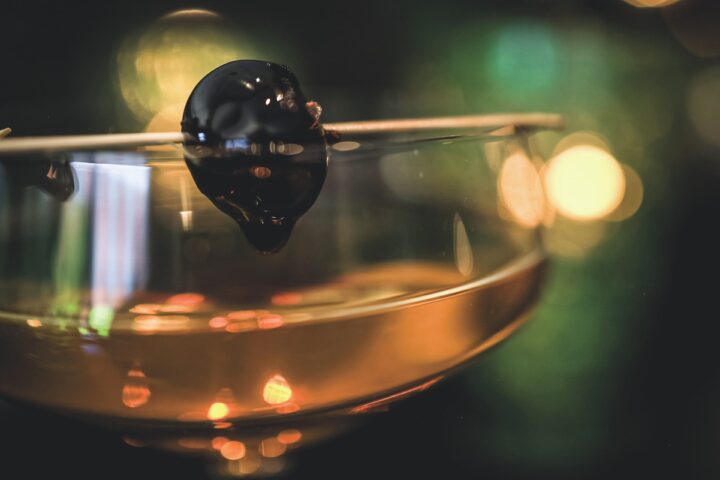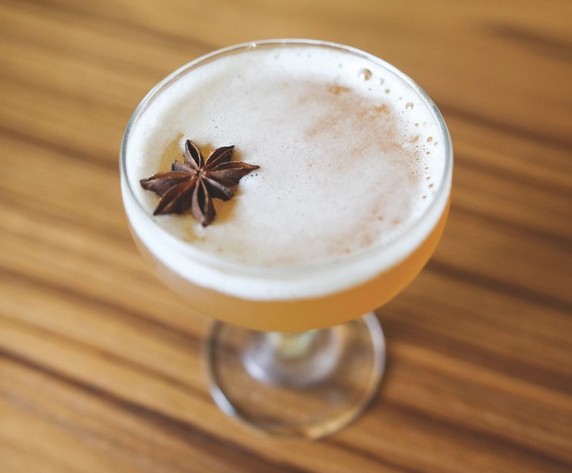
Abe Vucekovich, beverage director for Chicago’s Meadowlark Hospitality, notes that since the Covid-19 pandemic hit, at-home and professional bartenders alike are looking for more streamlined approaches to making cocktails. “They’re looking for less touches to drinks but still a lot of flavor, and amaro provides that,” he says. “An amaro is multi-dimensional in terms of flavor volume—everything is turned up to an 11 out of 10. You get a lot of ‘bang for your buck’ with an amaro when creating a cocktail.”
The Italian bitter liqueur certainly is a favorite among cocktail bartenders. “I love mixing with amaro because it’s an extremely versatile cocktail ingredient due to the variety of styles, including rich, sweet, dry, lightly bitter, very bitter, savory, earthy, spicy—the list goes on,” says Matty Carrol, director of beverage for The Kitchen Restaurant Group, which owns the restaurant brand The Kitchen in Denver and Boulder, Colorado, and Chicago. “You can add a lot of different accents and expressions to a cocktail depending on which amaro you choose, and in general, any of those types of flavors are delicious in cocktail applications and bring amazing character and balance to a recipe.”
Thomas Mizuno-Moore, senior beverage director for Chicago-based restaurant group Lettuce Entertain You, points out that an amaro is already a mini-cocktail on its own, since it features the key ingredients that make up a mixed drink, including alcohol, sugar, and bitters. “Because of this, amaro adds depth and complexity to cocktails in a way that would require so many different individual ingredients on their own to replicate,” he explains. “You can use amaro as a bridge between seemingly incongruous ingredients and find harmony and coherence where you might not have expected it.”

Darling Of The Industry
It’s no secret that bartenders have an affinity for amaro—in fact, Fernet-Branca is nicknamed “the bartender’s handshake” because it’s such a common bar order for hospitality workers. “Bartenders are bitter drinkers, and they’ve been sneaking little bits of amari to varying degrees in cocktails for years to the point that now people have grown to notice and even expect an amaro component in cocktails,” Meadowlark Hospitality’s Vucekovich says. “And cocktails that are now modern classics—the Paper Plane, Art of Choke, Midnight Stinger—have helped bring previously lesser-known amari to the forefront.” At Meadowlark’s restaurant Lardon, Vucekovich’s Fly Like Paper ($13) is a nod to the Paper Plane (equal parts Nonino amaro, Aperol aperitif, Bourbon, and lemon juice), comprising Montenegro amaro, Bordiga aperitivo, Four Roses Bourbon, and fresh lemon juice, plus Angostura bitters. “This drink showcases two wonderful amari,” Vucekovich adds. “Bordiga has a lot of body, slight bitterness, and a fair amount of candied orange and bitter orange, and Montenegro brings all the brighter orange notes like citrus oil and orange peel with a little vanilla to the party.” Similarly a twist on a modern classic, Vucekovich’s Between the Trees ($13) at Lardon is a riff on the White Negroni (gin, Suze gentian liqueur, and Lillet Blanc aperitif), blending the fennel-based amaro Don Ciccio & Figli Finocchietto with Letherbee gin, Apologue Persimmon liqueur, Istine Vermouth di Radda, and Peychaud’s bitters.
“As guests start leaning more into the cocktail world, their willingness to be adventurous and trust the bartender grows, which results in more people drinking amaro,” says Carrol of The Kitchen Restaurant Group. “One way I like to incorporate amaro into cocktails is to take a recipe that calls for sweet vermouth and use amaro instead—it fits a similar bill but adds an intriguing change to the overall delivery.”
He takes this approach with his Kanroku Manhattan #4 ($18.50), which is available at all locations of The Kitchen and features Nonino amaro, Suntory Toki whisky, El Maestro Sierra Pedro Ximénez Sherry, and a Fernet-Branca rinse. “I love mixing with Nonino—to me it strikes a perfect balance of dry, bitter, and earthy but with enough bright citrus and floral quality to keep it elegant and not overbearing,” Carrol adds. The I Was Never Given A Name ($14.50), which he created with bartender Ron Girotti, mixes equal parts Nonino and Myers’s Dark rum, plus Fernet-Branca, grapefruit juice, and Angostura bitters.

Alicia Hynes, bartender at Life on Mars in Seattle, also attributes the current popularly of amari to the bartenders who’ve been featuring them heavily on their menus. “It has helped guests discover how approachable these ingredients can be when used in cocktails well,” she says. “We offer a nice array of amari, from the common place brands like Cynar and Braulio to smaller more esoteric options like Vallet or Accompani. And some of our best-selling drinks feature amaro, which leads to a lot of guest questions on what exactly it is they’re drinking. It’s through answering these questions that we’re able to share different styles of amaro with our guests.” The Neil From Yonkers ($15), created by the venue’s co-owner Kraig Rovensky, is one such best-selling amaro cocktail, comprising Townshend’s Kashmiri amaro, Buffalo Trace Bourbon, rich Demerara simple syrup, and lemon juice. Hynes’ The Martyr ($16), meanwhile, blends Montenegro, Beefeater gin, The Pathfinder Hemp and Root (a non-alcoholic, amaro-style elixir), Fumus Pumila apple brandy, and rich Demerara simple syrup.
Many bartenders today act as unofficial ambassadors of amaro. “Chances are if you’ve had amaro, a bartender told you about it first,” says Chris Leavitt, assistant general manager and bar director at Anima by EDO in Las Vegas. “Since amari are so complex, using them in cocktails creates new conversations with guests, and as that continues to grow, so does amaro’s popularity.” At Anima by EDO, mixologist Joel Cockerill’s Bitter & Pitted ($14) mixes Campari aperitif, Old Forester 86 Proof Bourbon, Giffard Abricot de Ruisillon apricot liqueur, and lemon juice, topped with a foam comprising Angostura bitters and cherry.
“Amaro is so appealing to bartenders because it’s a blend of a lot of things we look for when making cocktails,” says Ben Potts, co-owner and bar manager of Beaker & Gray in Miami. “It’s got body, sweetness, complexity, and a variety of flavors.” His Borbory Bracer ($17) features Ramazzotti amaro, Redemption rye, Broadbent Reserve Madeira, house-made apricot syrup, and Bittercube Orange bitters, while his Zero Dark ($16) blends Montenegro, almond-infused Rémy Martin 1738 Cognac, Westland American single malt whiskey, Cointreau orange liqueur, Osborne Cream Sherry, simple syrup, and Bittercube Cherry Bark Vanilla bitters. “I tend to like amaro in stirred cocktails, but there’s a place for them in shaken drinks, too,” Potts adds. “You’ll even see some amaro present in tiki drinks.”

Surprisingly Versatile
As an ingredient that is itself bold and complex, amaro often winds up in heavier, spirit-forward drinks—but this is starting to change. “Amaro can seem like a big bold bully in terms of flavor, but I think it can be wildly versatile,” Meadowlark’s Vucekovich says. “Take Campari for example: It isn’t limited to only bitter and stirred drinks like the Negroni—you can shake up some fresh orange juice and two ounces of Campari to make a cold and frothy Garibaldi, where Campari is the star.” Vucekovich adds that particularly in the warmer months, amari are featured primarily in lighter Spritzes and refreshing cocktails at Lardon. His As If… ($12), for instance, comprises equal parts Ramazzotti Rosato aperitivo, Cocchi Rosa aperitivo, and Unión Uno mezcal, plus Terre Gaie Prosecco, fresh lemon juice, and simple syrup. “Ramazzotti Rosato is so floral with orange blossom and hibiscus and Cocchi Rosa furthers those floral notes—when mixed with earthy mezcal it creates this great juxtaposition of flavors, with a little citrus and effervescence brought in from the Prosecco.”
The Kitchen Restaurant Group’s Carrol notes that his perspective on how to use amaro in cocktails has changed quite a bit in recent years. “I’ve come to view amaro as an extremely versatile cocktail ingredient, whereas earlier in my career I kept it in its more traditional box of after-dinner sipper,” he says. “So for me, the evolution has been the realization that ‘hey, this is an extremely valuable tool to have in my cocktail kit.’”

Lettuce Entertain You’s Mizuno-Moore also notes the versatility of amaro, pointing out that “you can find an amaro for almost any job.” At the hospitality group’s restaurant Beatrix, his Rather Be Dry ($10) comprises Aperol, Martini & Rossi Floreale non-alcoholic white vermouth, fresh lemon juice, and soda water, while at Ema, his Villain Era ($15) blends Varnelli Amaro dell’Erborista, Buffalo Trace Bourbon, Licor 43 liqueur, Appel’s blackberry cordial, and fresh lemon juice. “Both of these drinks are refreshing, but in the Villain Era we use Amaro dell’Erborista, which is among the more bitter options in the market, with the only sweetener in it being a small amount of natural honey, and then in the Rather Be Dry we use category stalwart Aperol with its incredible flavor profile of orange zest, herbs, and vanilla to make a slightly bitter, low-abv, aperitivo-style drink in the Aperol Spritz family,” Mizuno-Moore adds. “There’s really no ceiling on the types of things that can be made with amaro.”
Indeed, amaro is such a vast category in terms of flavors and styles, there’s practically no end to its usefulness in cocktail creation. “You can go rich and dark with something like Fernet or Braulio, or go light and fruity with brands like Nonino or Meletti,” notes Hynes of Life on Mars. “As I started exploring the world of amaro more, I fell in love with the ability to create drastically different flavors that were way more robust than, say, a Margarita or Daisy riff. I remember when I first tried my mentor Kraig’s amaro-based drink called It’s A Wonderful Life I thought it tasted just like eggnog, but when I tasted all the ingredients separately, none of them tasted like that at all.” The aforementioned drink ($16) mixes equal parts Lucano amaro, Amorino amaro, Singani 63 brandy, Small Hand Foods orgeat syrup, and lime juice, plus aquafaba and Angostura bitters.
“Kraig always preaches that you need to understand classics and the building blocks of cocktails—but he also says that when it comes to amaro, because it’s so vast and constantly growing, to not be afraid to just try something totally new,” Hynes adds. “Recently I’ve noticed a surge in experimental amaro cocktails that feature more fruit notes and citrus as opposed to more traditional amaro cocktails that tend to be spirit-forward, dark, and bitter.” Life on Mars bartender Derrick Jones’ A Little Horse Named Paul Revere ($15) is one such experimental drink with fruit notes, blending Nardini Rosso aperitivo, St. George California Reserve Apple brandy, The Pathfinder Hemp and Root, and maple syrup, topped with Double Mountain Dry cider. At Anima by EDO, bartender Joe Arakawa similarly thinks outside the usual amaro cocktail box with his Blind Date ($16), which is a clarified drink featuring Ramazzotti Rosato, Lustau Brandy de Jerez, house-made mango shrub, yuzu juice, and rose water. “As bartenders discover the true expansiveness of the category, their creativity in utilizing amaro more frequently on cocktail menus has only helped amaro grow more popular,” Anima by EDO’s Leavitt says. “Overall, I think amaro-based drinks will continue to see growth in cocktail bars and restaurants with an eye toward creativity and complexity. As consumers continue to get educated on the category, the desire for creative use of amari will grow with it.”


